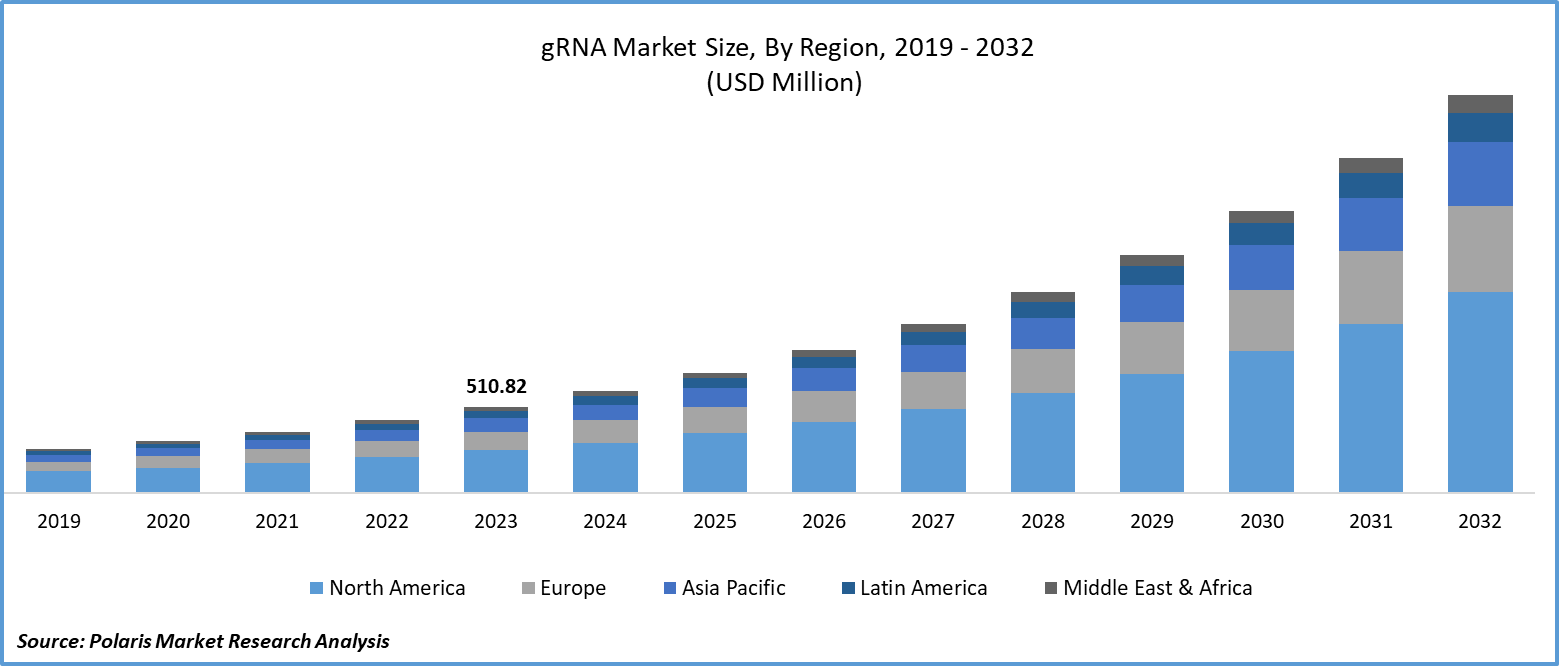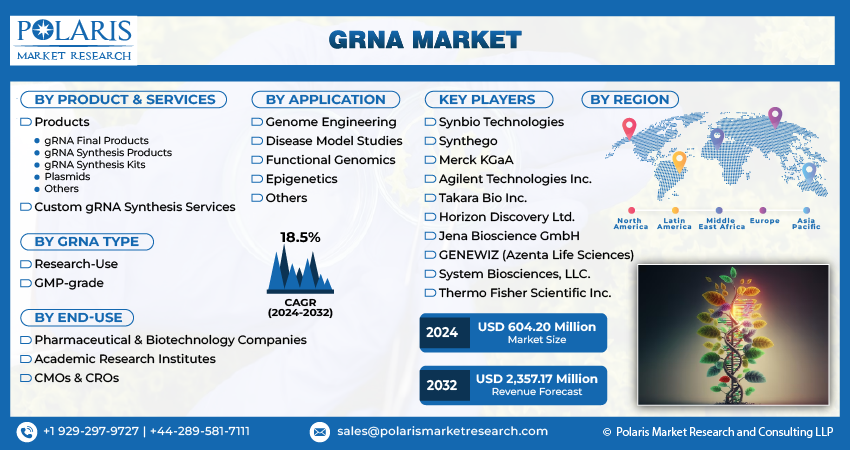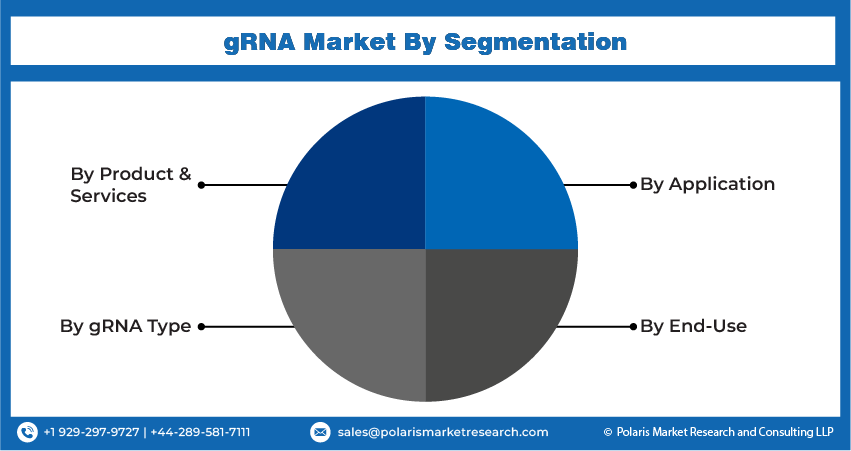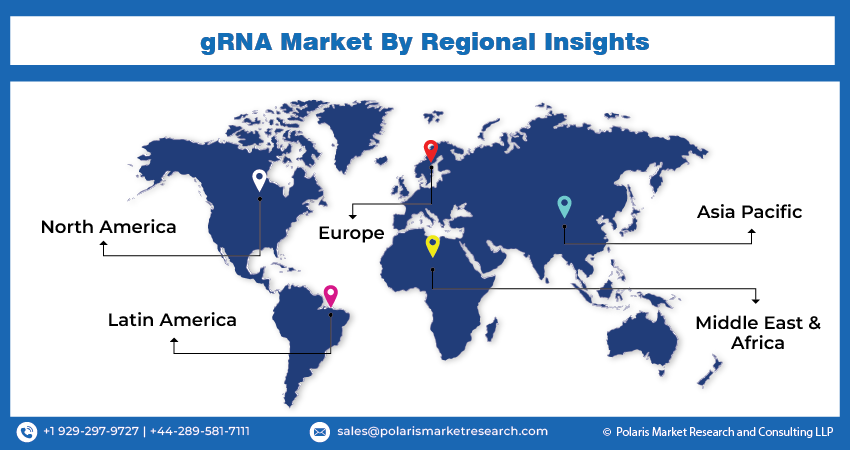
gRNA Market Share, Size, Trends & Industry Analysis Report
By Product & Services (Products, Custom gRNA Synthesis Services), By gRNA Type, By Application, By End-use, By Region; Segment Forecast, 2025 - 2034
- Published Date:Aug-2025
- Pages: 130
- Format: PDF
- Report ID: PM4327
- Base Year: 2024
- Historical Data: 2020 - 2023
The global gRNA Market was valued at USD 645.5 million in 2024 and is projected to grow at a CAGR of 20.40% from 2025 to 2034. Rapid advancements in gene editing technologies like CRISPR, along with rising R&D investments in genetic therapies, are key drivers of this high-growth market.
Market Overview
gRNA is experiencing significant demand owing to its crucial role in CRISPR-based genetic engineering. It has a unique capability to guide the CRISPR system to the specific DNA sequences in precise gene editing. Scientists and researchers depend on gRNA to accurately target & modify genes, leading to advancements in medicine, agriculture, & biotechnology. The versatility, precision, and efficiency of gRNA contribute to its high demand, holding the promise of potential cures for genetic disorders, new agricultural practices, & hidden molecular pathways.
- For instance, recently, in January 2023, a group of researchers in the Netherlands, Germany, & the United States, via multiple CRISPR-Cas9 screens, unveiled the translation of non-canonical open reading frames (ORFs) as a survival mechanism in cancer cells, specifically observed in childhood medulloblastoma. This form of cancer is recognized as the most prevalent among pediatric brain cancers.
CRISPR-Cas systems, initially derived from the bacterial immune system, serve as programmable genome editing tools. This technology relies on a guide RNA (gRNA) to specify the target and guide the nuclease module Cas, resulting in RNA-DNA binding as opposed to protein-DNA recognition. Cas9, the original nuclease in the CRISPR system, has been augmented by the inclusion of new Cas proteins in the CRISPR toolbox. These additions vary in size, immunogenicity, and functionality. Some are smaller, others are less likely to elicit an immune response, and certain ones have been engineered to carry out additional functions, such as recombinases and transposases. These non-nuclease-based technologies operate on mechanisms involving genome recombination and reshuffling.

To Understand More About this Research: Request a Free Sample Report
The applications of genome editing technologies encompass various areas, such as gene therapy and genetic engineering, aimed at correcting defective genes associated with monogenic genetic diseases. Additionally, these technologies play a crucial role in cell line engineering, facilitating the creation of new cell lines for both fundamental and applied research by inducing either gain or loss of function. They also find utility in diagnostics, enabling the recognition of specific sequences for the development of molecular diagnostic solutions. Moreover, genome editing technologies are integral to drug discovery and development processes, spanning from target identification to disease modeling. The aforementioned factors are likely to play vital role in driving the gRNA market growth.
Growth Factors
-
Innovations in proteomics and genomics
The market is witnessing substantial growth in research and development (R&D) activities in the fields of proteomics and genomics. Genomics-focused R&D endeavors aim to pinpoint and validate potential therapeutic targets while gaining insights into gene functions. In this process, gRNAs play a pivotal role, facilitating precise gene editing through CRISPR/Cas systems. Researchers leverage gRNAs to modify target genes, enabling the examination of their effects and streamlining the identification and validation of crucial targets. The R&D activities in proteomics and genomics frequently involve large-scale studies to uncover the functions of genes and proteins. gRNAs are integral to functional genomics research, empowering researchers to selectively knock out or modulate specific genes, contributing to a deeper understanding of gene function and unraveling intricate biological pathways. Thus, driving the gRNA market demand in the extended run.
-
Rising necessity of personalized treatment
The application of gRNA technology has demonstrated promise in two key domains, giving rise to the creation of swift COVID-19 tests based on CRISPR and the exploration of CRISPR-based antiviral therapies. The global pandemic has significantly heightened public awareness and interest in gene-editing technologies like CRISPR-Cas9, amplifying the acknowledgment of gRNA's potential and fostering increased market demand and awareness. The COVID-19 crisis underscored the significance of personalized medicine, as individuals exhibited diverse responses to the virus.
For instance, in March 2021, a team of scholars from Nanyang Technological University developed the VaNGuard (Variant Nucleotide Guard) diagnostic test. The capability of this test to detect mutations in SARS-CoV-2 strains is poised to elevate the utilization of CRISPR genome editing technology within the diagnostics sector. Such factors are projected to contribute the product demand and spur the gRNA market development.

Restraining Factors
Scalability and capacity shortage limiting growth
The challenges in scaling up genome editing-based cell therapies mirror those encountered in other ex vivo cell therapies. The nature of these challenges varies based on whether the therapies are autologous or allogeneic. The primary hurdle in autologous therapies is the incorporation of personalization, which introduces variability in both qualitative and quantitative aspects of the process, such as the number of cells harvested from each patient. Scaling up allogeneic cell therapies presents various challenges, particularly in relation to scalability.
Report Segmentation
The market is primarily segmented based on product & services, gRNA type, application, end-use, and region.
|
By Product & Services |
By gRNA Type |
By Application |
By End-Use |
By Region |
|
|
|
|
|
To Understand the Scope of this Report: Speak to Analyst
By Product & Services Insights
Custom gRNA synthesis segment is expected to witness highest growth during forecast period
The custom gRNA synthesis segment is projected to grow at a CAGR during the projected period. Biotechnology companies focusing on gene editing technologies deliver these services, presenting researchers with diverse options to design and order custom gRNAs tailored to their specific experimental requirements. This significantly contributes to the growth of the segment.
The product segment led the gRNA market size with a substantial revenue share in 2023. These products are favored by researchers for their notable attributes of high accuracy, efficiency, and specificity in gene editing. Apart from the products, the market provides various services, including gRNA design, synthesis, and delivery. These services empower researchers to personalize their gene editing experiments with custom gRNA sequences and delivery systems, enhancing accuracy and specificity in the process. The widespread availability and high purity of these products are key factors contributing to the dominance of this segment.
By gRNA Type Insights
Research use segment accounted for the largest market share in 2024
In 2023, the research use segment accounted for the largest market share. The substantial demand for research-grade gRNA is driven by numerous research programs conducted across diverse research institutes. As gRNA finds expanding applications in clinical research, it is anticipated that this segment will continue to dominate over the forecast period. Additionally, the increasing adoption of the CRISPR/Cas9 technology, mostly utilized in the gene-editing tool, further contributes to the heightened demand for the gRNA in research.
The GMP grade segment is expected to grow at the fastest growth rate over the coming years. This segment is dedicated to producing gRNA under rigorous quality control and regulatory standards, specifically for application in clinical trials and patient treatment. Adherence to Good Manufacturing Practices (GMP) guarantees consistent and controlled manufacturing of products, ensuring a high level of quality assurance. This is particularly crucial in medical applications, where safety and efficacy are paramount. The presence of GMP-grade gRNA products is expected to propel the gene editing market, especially in the realm of personalized medicine.

Regional Insights
North America region dominated the global market in 2024
North America dominated the global market with the largest market share in 2023. The region's leadership in the gRNA industry can be attributed to factors such as the significant presence of key players and a notable increase in research and development investments by these entities to pioneer innovative and advanced products. For instance, in May 2023, Thermo Fisher & Pfizer, Inc. collaborated to expand access to NGS-based testing for cancer patients. This revolves around lung & breast cancer, two prevalent and serious cancers worldwide.
Asia Pacific is expected to be the fastest-growing region. This growth is primarily due to the substantial target population, swift adoption of various technologies, the emergence of numerous startups, the ongoing market development of healthcare infrastructure, and the presence of considerable unmet clinical needs. The Chinese government has instituted various policies aimed at fostering the growth of the biotech industry. These initiatives encompass tax incentives, financial support for R&D, and streamlined regulatory procedures. Consequently, these measures have attracted both domestic and foreign companies to invest significantly in the region.

Key Market Players & Competitive Insights
Strategic partnerships to drive the competition
Many participants in the gRNA market are opting for licensing agreements with technology developers as part of their strategy to strengthen their market presence. Over the recent years, several research programs have been launched utilizing CRISPR-based gene editing to explore potential treatment options for chronic diseases. For instance, in May 2023, a notable research initiative conducted at the Lewis Katz School of Medicine at the University of Nebraska Medical Center reported a successful treatment of HIV infection in animals. The program employed CRISPR to deactivate CCR5 and remove HIV-1 DNA fragments from infected cells.
Some of the major players operating in the global market include:
- Agilent Technologies Inc.
- GENEWIZ (Azenta Life Sciences)
- Horizon Discovery Ltd.
- Jena Bioscience GmbH
- Merck KGaA
- Synbio Technologies
- Synthego
- System Biosciences, LLC.
- Takara Bio Inc.
- Thermo Fisher Scientific Inc.
Recent Developments in the Industry
- In Decemeber 2024, Editas Medicine announced it is dropping its ex vivo gene editing programs—including the reni‑cel oncology candidate—shifting entirely to in vivo CRISPR therapies delivered via nanoparticles targeting liver and blood stem cells.
- In April 2022, Thermo Fisher Scientific introduced the Gibco CTS TrueCut Cas9 Protein, emphasizing its role as a high-quality support material. Comprehensive documentation is deemed crucial as researchers employing genome editing techniques transition from basic research to therapeutic applications.
- In July 2022, Synthego inaugurated a manufacturing facility covering 20,000 square feet, with a focus on producing GMP single guide RNA (sgRNA) on a large scale.
Report Coverage
The gRNA market report emphasizes on key regions across the globe to provide better understanding of the product to the users. Also, the report provides market insights into recent developments, trends and analyzes the technologies that are gaining traction around the globe. Furthermore, the report covers in-depth qualitative analysis pertaining to various paradigm shifts associated with the transformation of these solutions.
The report provides detailed analysis of the gRNA market development while focusing on various key aspects such as competitive analysis, product & services, gRNA type, application, end-user, and their futuristic growth opportunities.
gRNA Market Report Scope
|
Report Attributes |
Details |
|
Market size value in 2025 |
USD 735.4 million |
|
Revenue forecast in 2034 |
USD 3750.8 million |
|
CAGR |
20.40% from 2025 – 2034 |
|
Base year |
2024 |
|
Historical data |
2020 – 2023 |
|
Forecast period |
2025 – 2034 |
|
Quantitative units |
Revenue in USD million and CAGR from 2025 to 2034 |
|
Segments covered |
|
|
Regional scope |
|
|
Competitive Landscape |
|
|
Report Format |
|
|
Customization |
Report customization as per your requirements with respect to countries, region, and segmentation. |
FAQ's
The gRNA Market report covering key segments are product & services, gRNA type, application, end-use, and region.
gRNA Market Size Worth $3750.8 Million By 2034
gRNA market exhibiting the CAGR of 20.40% during the forecast period.
North America is leading the global market
key driving factors in gRNA Market are Rising necessity of personalized treatment
